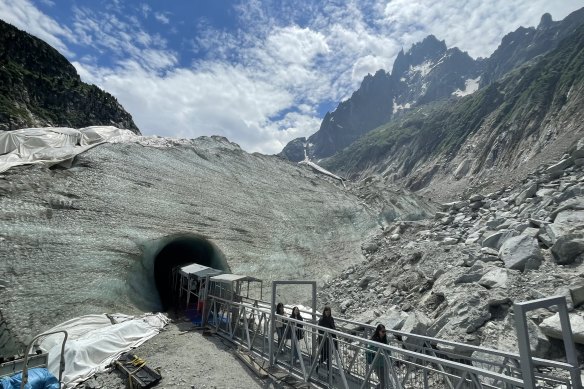A train ride to one of Europe’s natural wonders takes just 20 minutes
Given the terrifying rate at which most of the world’s glaciers are retreating, it’s hard to imagine the reverse scenario. But that’s exactly what happened during Europe’s Little Ice Age, a period between 1300 and 1850 when many of the continent’s glaciers went through a sustained growth spurt.
Nowhere was this more apparent than on the Mont Blanc massif, a 46-kilometre granite goliath in the Alps that has dozens of glaciers snaking down its vertiginous flanks. As the glaciers threatened to engulf communities within the Chamonix valley, bishops performed exorcisms on the “possessed” ice flows in a bid to stop their indefatigable advance.

The train from Montenvers heads towards the Mer de Glace (Sea of Ice), which is flanked by mountains.
While the massif is still home to about 90 active glaciers, one stands head and shoulders – both symbolically and dimensionally – above the rest. The Mer de Glace (Sea of Ice) is France’s longest glacier, an 11-kilometre river of ice that starts at an altitude of 4200 metres and then squirms down a dramatic mountain-flanked chasm towards the neighbourhood of Les Bois.
There are two ways to reach it from Chamonix – hike uphill for three hours through a dense spruce forest or catch the Montenvers train, a scenic cogwheel railway that makes the same journey in 20 minutes. No prizes for guessing which option I take.
After being delivered to the rail terminus at 1913 metres, we spill out onto an elevated terrace with sweeping views over the yawning glacial valley. It’s estimated that the glacier has thinned by about 160 metres over the past 35 years, evidence of which is clearly visible on the valley’s scoured rock walls. If the glacier continues receding at the current rate, it’s predicted that in 200 years, it will have retreated four kilometres up the valley.

The entrance to ice tunnels inside the Mer de Glace glacier.
Despite this bleak prognosis, it’s still a genuinely arresting sight – a gravel-strewn slab of ice flanked by a curtain of soaring peaks, including the imposing north face of the Grandes Jorasses (4208 metres) and the spire-like Aiguille du Dru (3754 metres).
The view alone is worth the price of the train ticket, but the complex is also home to several intriguing attractions, the most improbable being the Ice Cave, a labyrinth of tunnels that has been quarried out of the glacier annually by the same local family since 1946.
After catching a gondola down into the valley, I descend a 170-step metal staircase (be warned: you have to come back up this, too) and then plunge into the glacier’s icy innards. Immediately, the temperature plummets and the low lighting makes the hand-chiselled tunnel walls glow an ethereal shade of Bombay Sapphire blue.
A circular route lined with information bulbs passes exhibits on the water cycle and the history of the glacier, along with an area containing ice sculptures of a bar and a fireplace.
For more interpretation in a balmier setting, a separate Glaciorium has interesting displays on glaciology and the effects of climate change. Also worth a look is the Temple of Nature, an old stone mountain refuge hut, where a short video plays inside and explains the history of tourism to the glacier.

An ice cave inside the glacier.
After the valley was discovered by British explorers William Windham and Richard Pococke in 1741, it became a popular tourist attraction, luring literary luminaries like Charles Dickens, Victor Hugo and Lord Byron.
Many went on to wax lyrical about this extraordinary natural wonder, but for my money, Mary Shelley captured it best. After visiting the glacier with her poet husband in 1816, she wrote: “It exhibits an appearance as if frost had suddenly bound up the waves and whirlpools of a mighty torrent.”
The details

The train at Montenvers gives passengers a scenic ride to the glacier.
Tour
Explore Worldwide’s eight-day Highlights of Mont Blanc trip includes seven nights’ accommodation in Les Houches, five days of guided hikes and a free day to explore attractions such as the Mer de Glace. From $3460 a person. See exploreworldwide.com.au
Visit
The glacier is accessible year-round, but the train is closed every November for maintenance. Trains depart from 35 Place de la Mer de Glace, Chamonix, and a return ticket covering the train, gondola ride and ice cave access costs from €38 ($60). See montblancnaturalresort.com/en
Fly
Emirates flies to Geneva via Dubai. Mountain Drop-offs operates a regular shuttle service from Geneva Airport to the Chamonix valley. It costs from €50 ($80) one-way. See emirates.com; mountaindropoffs.com
More
en.chamonix.com
The writer was a guest of Explore Worldwide.
Sign up for the Traveller Deals newsletter
Get exclusive travel deals delivered straight to your inbox. Sign up now.